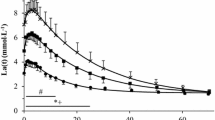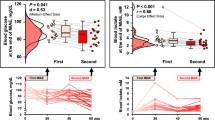Summary
We attempted to determine the change in total excess volume of CO2 Output (CO2 excess) due to bicarbonate buffering of lactic acid produced in exercise due to endurance training for approximately 2 months and to assess the relationship between the changes of CO2 excess and distance-running performance. Six male endurance runners, aged 19–22 years, were subjects. Maximal oxygen uptake (VO2max), oxygen uptake (VO2) at anaerobic threshold (AT), CO2 excess and blood lactate concentration were measured during incremental exercise on a cycle ergometer and 12-min exhausting running performance (12-min ERP) was also measured on the track before and after endurance training. The absolute magnitudes in the improvement due to training for C02 excess per unit of body mass per unit of blood lactate accumulation (Ala−) in exercise (CO2 excess·mass−1·Δla−), 12-min ERP, VO2 at AT (AT-VO2) and VO2max on average were 0.8 ml·kg−1·l−1·mmol−1, 97.8m, 4.4 ml·kg−1· min−1 and 7.3 ml·kg−1·min−1, respectively. The percentage change in CO2 excess·mass−1·Δla− (15.7%) was almost same as those of VO2max (13.7%) and AT-VO2 (13.2%). It was found to be a high correlation between the absolute amount of change in CO2 excess·mass−1·Δla− and the absolute amount of change in AT-VO2 (r=0.94, P<0.01). Furthermore, the absolute amount of change in C02 excess·mass−1·Δla−, as well as that in AT-VO2 (r=0.92, P<0.01), was significantly related to the absolute amount of change in 12-min ERP (r=0.81, P<0.05). It was concluded that a large CO2 excess·mass−1·Δla−1 of endurance runners could be an important factor for success in performance related to comparatively intense endurance exercise such as 3000–4000 m races.
Similar content being viewed by others
References
andersen P (1975) Capillary density in skeletal muscle of man. Acta Physiol Scand 95:203–205
Beaver WL, Wasserman K (1991) Muscle RQ and lactate accumulation from analysis of the VCO2-VO2 relationship during exercise. Clin J Sport Med 1:27–34
Beaver WL, Wasserman K, Whipp BJ (1986) Bicarbonate buffering of lactic acid generated during exercise. J Appl Physiol 60:472–478
Bouissou P, Defer G, Guezennec CY, Estrade PY, Serrurier B (1988) Metabolic and blood catecholamine responses to exercise during alkalosis. Med Sci Sports Exerc 20:228–232
Davis JA, Frank MF, Whipp BJ, Wasserman K (1979) Anaerobic threshold alterations caused by endurance training in middle-aged man. J Appl Physiol 46:1039–1046
Hadjivassiliou AG, Pieder SV (1968) The enzymatic assay of pyruvic and lactic acids. A definitive procedure. Clin Chim Acta 19:357–361
Hirakoba K, Maruyama A, Misaka K (1987) Dynamics of VCO2 and VE during incremental exercise and aerobic work capacity. Kyushu J Phys Educ Sports (Japan) 1:37–44
Hirakoba K, Maruyama A, Misaka K (1990) Relationship between CO2 excess due to lactic acid production during exercise and endurance performance. Jpn J Phys Fitness Sports Med 39:69–77
Hultman E, Sahlin K (1980) Acid-base balance during exercise. Exerc Sport Sci Rev 8:41–128
Jones NL, Sutton JR, Taylor R, Towes CJ (1977) Effect of pH on cardiorespiratory and metabolic responses to exercise. J Appl Physiol 43:959–964
Kowalchuk JM, Heigenhauzer GJF, Lindinger MI, Obminski G, Sutton JR, Jones NL (1988) Role of lungs and inactive muscle in acid-base control after maximal exercise. J Appl Physiol 65:2090–2096
Mainwood GW, Renaud JM (1985) The effect of acid-base balance on fatigue of skeletal muscle. Can J Physiol Pharmacol 63:403–416
Parkhouse WS, McKenzie DC, Hochachka PW, Ovalle WK (1985) Buffering capacity of deproteinized human vastus lateralis muscle. J Appl Physiol 58:14–17
Sharp RL, Armstrong LE, King DS, Costill DL (1983) Buffer capacity of blood in trained and untrained males. In: Knuttgen HG, Vogel JA, Poortsmans J (eds) Biochemistry of exercise. Human Kinetics Publishers, Champaign, Ill., pp 595–599
Sjogaard G (1984) Changes in skeletal muscles capillarity and enzyme activity with training and detraining. Med Sport Sci 17:202–214
Sutton JR, Jones NL (1979) Control of pulmonary ventilation during exercise and mediators in the blood: CO2 and hydrogen ion. Med Sci Sports Exerc 11:198–203
Trivedi B, Danforth WH (1966) Effect of pH on the kinetics of frog muscle phosphofructokinase. J Biol Chem 241:4110–4114
Wasserman K, Whipp BJ, Koyal SN, Beaver WL (1973) Anaerobic threshold and respiratory gas exchange during exercise. J Appl Physiol 35:236–243
Wasserman K, Whipp BJ, Davis JA (1981) Respiratory physiology of exercise: metabolism, gas exchange, and ventilatory control. In: Widdicombe JG (ed) Respiratory physiology III, International review of physiology. University Park Press, Baltimore, pp 149–211
Wilkes D, Gledhill N, Symth R (1983) Effect of acute induced metabolic alkalosis on 800-m racing time. Med Sci Sports Exerc 15:277–280
Yano T (1987) The differences in CO2 kinetics during incremental exercise among sprinters, middle, and long distance runners. Jpn J Physiol 37:369–378
Yano T, Asano K, Nomura T, Matsuzaka A, Hirakoba K (1984) Kinetics of VCO2 during incremental exercise. Jpn J Phys Fitness Sports Med 33:201–210
Author information
Authors and Affiliations
Rights and permissions
About this article
Cite this article
Hirakoba, K., Maruyama, A., Inaki, M. et al. Effect of endurance training on excessive CO2 expiration due to lactate production in exercise. Europ. J. Appl. Physiol. 64, 73–77 (1992). https://doi.org/10.1007/BF00376444
Accepted:
Issue Date:
DOI: https://doi.org/10.1007/BF00376444




